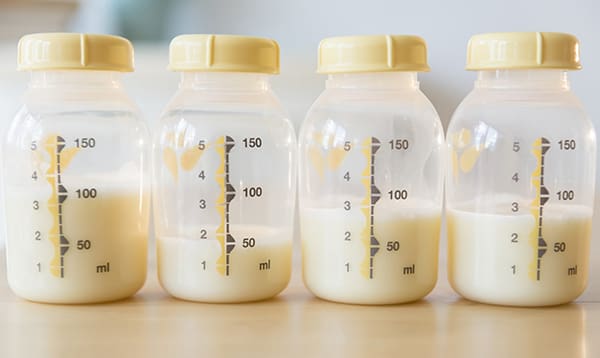By Ali Weatherford
High lipase milk is something you may not ever hear about if you don’t have the problem. It’s a condition of breast milk that used to be treated as a problem, but newer information has changed that!
When breast milk is pumped or expressed and then refrigerated or frozen, it may develop an odor. This is due to a natural change in the fatty acids in the milk caused by the lower temperatures. It’s actually a process that helps prevent the growth of microorganisms in the milk, so it may mean that this milk is extra safe and nutritious!
High Lipase Milk is Safe
The odor might be mild, or it might be pretty strong and unpleasant. It is actually harmless though. It’s perfectly safe to use this milk to feed your baby. There are many normal and healthy foods that have a bad odor. Broccoli, certain cheeses, hard boiled eggs, fish, and other foods are known for having strong odors. They don’t usually taste the way they smell, and the smell definitely doesn’t mean the food is bad, spoiled, or unsafe to eat.
There are still some myths floating around about high lipase milk, and it can be really devastating to believe those rumors and throw away perfectly good milk.
Are You Using Safe Storage Practices?
As long as you are following safe handling and storage guidelines for your breast milk collection, the smelly milk is most likely perfectly safe to use. High lipase milk has an odor that some people describe as metallic, soapy, or even fishy. The taste might be very different from the smell, or it might also taste bad depending on the severity.
If the milk smells rancid or spoiled, that might be a different problem. As long as you’re following good handling and storage procedures, it’s very unlikely that the milk is spoiled or bad.
However, there is one other cause of bad smelling milk that you might look into. If it smells sour or rancid and you know it’s not due to dirty pump parts or bad storage conditions, it could be caused by chemical oxidation. This means that you’ve either eaten some rancid fats like nuts or fish oil supplements, or you’ve been drinking water that’s high in copper or iron. If a bad smell is caused by chemical oxidation, you should not give the milk to your baby. Here’s how to know if that’s the problem:
- Just smell and taste the milk right after you pump or express! If it doesn’t have a strong smell and it tastes a little sweet and good, you don’t have that problem. Chemical oxidation happens in the body, NOT after refrigeration or freezing, so it’s easy to tell just by trying the milk immediately after removing it from the breast.
- If you find out that you are experiencing chemical oxidation, be sure to stop ingesting any products or foods you’ve been using that might contain rancid fats. That includes nuts and a lot of different oils ranging from foods to supplements. Also try drinking bottled water until you figure out the source of the problem.
What if my Baby Doesn’t Like my High Lipase Milk?
Many babies don’t reject high lipase milk, but what should you do If you suspect that your baby does have a harder time drinking it because of the smell or taste?
- Try mixing it with some freshly pumped or expressed milk. So, this means mixing half and half with milk that was pumped within the last 4 hours and has not been refrigerated or frozen.
- Test your milk. Sometimes it takes just a few hours of colder temperatures for the high lipase levels to affect the smell of the milk. Other times it takes days of being frozen before the problem develops. You can test yours to see when the change happens. It can help to know this so if your baby is bothered by it, you can just be sure to use the milk before it starts to smell. You might also test whether your milk starts to smell only after being frozen, or if refrigeration also causes it. For some people, it only happens after freezing and you might discover that you can store smaller amounts in the refrigerator as long as you use it within 4 days.
Resources
La Leche League International article
Breastfeeding Success High Lipase Milk How-to Guide
Cassie Terrillion, IBCLC and Breastfeeding Educator

